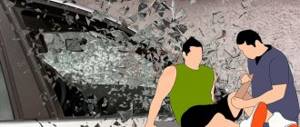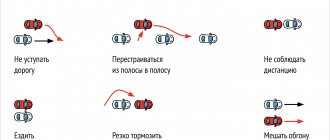Russia is one of the world leaders in the number of injured and killed in road accidents. In 2021 alone, road accidents claimed 18 thousand lives. This is the population of a small town. The number of non-fatal victims is 215 thousand. The problem is aggravated by the fact that most of the dead and injured are young and healthy people before the accident.
Those responsible for road accidents bear several types of liability - administrative, civil, criminal. A variety of penalties are provided for drivers and vehicle owners - from small fines for causing damage to health to long-term isolation from society if there are serious consequences.
An advantageous offer from the partners of our portal - Terem Loan! Apply for a loan in the amount of up to 30 thousand rubles for a period of up to 30 days.
100% approval!
Get money
Types of liability
At the legislative level, 3 types of liability are established in case of an accident causing harm to health and life:
- civil;
- administrative;
- criminal
Civil liability consists of compensating harm to injured persons and rests with vehicle owners. It occurs under any circumstances, regardless of whether the driver is guilty of causing an accident or not, due to the fact that the car is defined by the Civil Code as a source of increased danger (Article 1079 of the Civil Code of the Russian Federation).
Administrative and criminal liability depends on the type of offense (crime) committed by the guilty person. These types of liability do not apply at the same time. The degree of guilt and type of punishment are determined taking into account the consequences of the accident.
These types of liability are borne by direct participants in the accident, as well as by persons responsible for the circumstances that led to the accident. Most often, vehicle drivers are responsible for accidents with injuries and deaths.
Causing grievous bodily harm in an accident
This is one of the most serious situations. Serious bodily harm in an accident is a reason for criminal prosecution of the culprit of the accident. The case is initiated based on the results of a forensic medical examination. According to severity, harm is divided into:
- easy;
- average;
- heavy
The last degree is the most dangerous for humans. Serious harm is a high probability of death during an accident or some time after it, loss of vital body functions.
The qualifying signs of grave harm, according to clause 4 of the Rules for determining the severity of harm caused to human health, approved by Decree of the Government of the Russian Federation of August 17, 2007 No. 522, are:
- harm dangerous to human life;
- loss of vision, speech, hearing or any organ or loss of organ functions;
- abortion;
- mental disorder;
- drug addiction or substance abuse;
- permanent facial disfigurement;
- significant permanent loss of general ability to work by at least one third;
- complete loss of professional ability...
To classify harm to health as serious, it is sufficient to have at least one of the injuries that threaten a person’s life or lead to a dangerous condition, including:
- coma;
- shock 3-4 degrees;
- excessive blood loss;
- cardiac, renal, respiratory failure;
- a head wound penetrating the skull or an intracranial wound;
- cervical injuries;
- spine fracture;
- open and closed chest injuries;
- multiple rib fractures;
- penetration into the abdominal cavity;
- loss of vision, speech, hearing;
- loss of any organ, etc.
The full list of medical criteria for serious harm is contained in paragraph 6 of the Appendix to Order of the Ministry of Health and Social Development dated April 24, 2008 No. 194n.
Classification of health damage in road accidents
Any harm to health that one person causes to another is divided into two types:
- Deliberate. In this case, a person deliberately inflicts injuries, injuries, beatings, and creates conditions in which the victim will be injured or die.
- Unintentional. In this case, the perpetrator may unknowingly, for the purpose of self-defense, in an accident cause injury, injury, or death.
Unintentional harm to health occurs:
- Easy. A situation where the victim received abrasions, bruises, or a slight nervous shock. Maybe he refused medical help altogether or was given valerian to drink (as an example).
- Moderate weight. This type of harm is the most “slippery” and unstable. Injuries after an accident are considered to be of moderate severity, but very often, several years after the accident, serious consequences of injuries can appear. In this case, the victim or his relatives have the right to sue again and demand recognition of not moderate, but serious harm to health. The cost of treatment will be paid by the person responsible for the accident, based on the court decision. The court, in turn, relies on irrefutable evidence from forensic experts who will confirm in writing that health problems and death occurred after a long time precisely because of the accident. The court may also review the case as a criminal case and impose a prison term.
- Serious harm. This category includes injuries that lead to loss of life; vision or hearing loss; facial disfigurement; damage and removal of organs (internal, including); miscarriage, termination of pregnancy at any stage; mental disorders; loss of ability to work, including professional disability of at least 30%; death of a passenger, pedestrian, other driver, or road user.
If for mild and proven moderate harm to health there is an administrative penalty, then for serious harm to health - only criminal, even for causing grievous harm to health through negligence in an accident.
This means that the driver who is at fault for an accident that causes someone to be very seriously injured or die, becomes disabled, or loses limbs or internal organs is facing criminal charges. And it is not at all necessary that he be drunk.
What does a driver face for an accident with serious bodily injury?
Such an offense can be punishable by up to 15 years. The punishment for causing grievous harm in an accident is established by the Criminal Code of the Russian Federation.
The type of sanction is determined by the court individually and depends on:
- on the condition of the driver at the time of the accident;
- assessing the severity of the harm caused;
- the presence of mitigating or aggravating circumstances.
Liability measures for serious injury to health due to negligence (Article 264 of the Criminal Code of the Russian Federation) are presented in the table. The choice of a specific punishment is made by the judge.
| Types of sanctions | |||
| Restriction of freedom | Forced labor | Arrest | Deprivation of liberty |
| Part 1 Art. 264 of the Criminal Code of the Russian Federation: Violation by the driver of traffic rules or vehicle operating rules, resulting in serious harm | |||
| up to 3 years | up to 2 years + deprivation of the right to occupy a position positions or engage in op. activities up to 3 years or without it | up to 6 months | up to 2 years + deprivation of the right to occupy a position positions or engage in op. activities up to 3 years or without it |
| Part 2 Art. 264 of the Criminal Code of the Russian Federation: An act provided for in Part 1, committed while intoxicated or involving leaving the scene of an accident | |||
| up to 5 years + deprivation of the right to occupy a position positions or engage in op. activities up to 3 years | from 3 to 7 years + deprivation of the right to occupy a position. positions or engage in op. activities up to 3 years | ||
| Part 3 Art. 264 of the Criminal Code of the Russian Federation: An act provided for in Part 1, resulting in the death of a person | |||
| up to 4 years + deprivation of the right to occupy a position positions or engage in op. activities up to 3 years | up to 5 years + deprivation of the right to occupy a position positions or engage in op. activities up to 3 years | ||
| Part 4 Art. 264 of the Criminal Code of the Russian Federation: An act provided for in Part 1, committed in a state of intoxication or or associated with leaving the scene of an accident and resulting in the death of a person | |||
| from 5 to 12 years + deprivation of the right to occupy a position. positions or engage in op. activities up to 3 years | |||
| Part 5 Art. 264 of the Criminal Code of the Russian Federation: An act provided for in Part 1, resulting in the death of 2 or more persons | |||
| up to 5 years + deprivation of the right to occupy a position positions or engage in op. activities up to 3 years | up to 7 years + deprivation of the right to occupy a position positions or engage in op. activities up to 3 years | ||
| part 6 art. 264 of the Criminal Code of the Russian Federation: An act provided for in Part 1, committed while intoxicated or involving leaving the scene of an accident and resulting in the death of 2 or more persons | |||
| from 8 to 15 years + deprivation of the right to occupy a position. positions or engage in op. activities up to 3 years | |||
The presence of intent aggravates the position of the culprit. An intentional traffic accident resulting in serious injury to health is considered under Article 111 of the Criminal Code. The maximum penalty under this article is 15 years of imprisonment with or without restriction of freedom for up to two years.
Judicial practice shows that when making a decision determining the punishment for the culprit, the position of the accused has a great influence. Sincere repentance and voluntary compensation for harm to the victim, the absence of claims from the injured parties make it possible to change the measure of responsibility to a more lenient one and mitigate the punishment.
An example from judicial practice
Driver K., while driving a vehicle, violated the traffic rules, which led to an accident, which resulted in the death of citizen F. At the court hearing, the offender did not admit guilt. According to Part 3 of Art. 264 of the Criminal Code of the Russian Federation, the court sentenced the driver of the vehicle who violated the traffic rules to 1 year and 6 months of imprisonment to be served in a penal colony with deprivation of the right to engage in driving vehicles for 2 years.
Citizen K. filed an appeal to a higher court. During the hearing, he renounced some of his objections and fully pleaded guilty to the accident. The Court of Appeal granted the defendant's complaint in part, taking into account the admission of guilt, compensation for moral damage, lack of criminal record and positive characteristics. The imprisonment was suspended and a probationary period was established.
What does the culprit of an accident with victims face?
Depending on the severity of the harm caused to health, the liability of the perpetrator of an accident with victims is established in accordance with administrative or criminal legislation. Administrative punishment is applied in the following cases:
1. Violation of the Rules..., resulting in minor harm to the health of the victim, entails the imposition of an administrative fine in the amount of two thousand five hundred to five thousand rubles or deprivation of the right to drive vehicles for a period of one to one and a half years.
2. Violation... resulting in the infliction of moderate harm to the health of the victim shall entail the imposition of an administrative fine in the amount of ten thousand to twenty-five thousand rubles or deprivation of the right to drive vehicles for a period of one and a half to two years.
Art. 12.24 Code of Administrative Offences.
Criminal liability arises when life-threatening injuries, mutilations and other serious consequences are caused as a result of an accident. In this case, the penalty is imprisonment for up to two years:
Violation... resulting through negligence in causing grievous harm to human health, is punishable by restriction of freedom for a term of up to three years, or forced labor for a term of up to two years with deprivation of the right to hold certain positions or engage in certain activities for a term of up to three years or without it, or arrest for a term of up to three years. a term of up to six months, or imprisonment for a term of up to two years with or without deprivation of the right to hold certain positions or engage in certain activities for a term of up to three years.
Art. 264 of the Criminal Code of the Russian Federation.
The period may be increased to 3 years in the presence of aggravating circumstances. The latter most often is a state of intoxication revealed during a medical examination. Materials for deprivation of rights in case of an accident with victims in this case are sent administratively to the court immediately. This does not affect the criminal proceedings in any way - the court decision is simply attached to the case.
Determining the severity of harm to health
Fatal accident
Causing minor harm to health
Medical criteria for minor harm are short-term health impairment (up to 3 weeks) and minor permanent disability (less than 10%). A health disorder is understood as a temporary impairment of the functions of human organs and systems.
Not all injuries are considered minor injuries. Superficial damage to the skin - bruises, abrasions, contusions, if they do not lead to loss of ability to work and health problems, are not regarded as causing harm.
Due to the fact that ambulance doctors and traffic inspectors cannot assess injuries on the spot, at first all traffic accidents with injured people are automatically classified as mild accidents. After this, upon the victim’s visit to a medical facility, doctors assess the degree of harm caused.
What will be the light damage in an accident in 2021?
Punishment for causing minor harm to health after an accident is imposed under Article 12.24 of the Code of Administrative Offenses of the Russian Federation. The degree of guilt of the participants is established as a result of an administrative investigation.
The minimum sanctions are an administrative fine from 2,500 to 5,000 rubles. It can be imposed by officials of the road inspection - the head of the traffic police, his deputy, the commander of the traffic police regiment and his deputy. (Article 23.3 of the Code of Administrative Offenses of the Russian Federation). In court, a driver can be deprived of his license for a period of 1 to 1.5 years.
Criminal liability may arise if there is intent to cause minor harm (Part 1 of Article 115 of the Criminal Code of the Russian Federation). Possible sanctions:
- fine up to 40 thousand rubles. or in the amount of the convicted person’s earnings for a period of up to 3 months;
- compulsory work up to 480 hours;
- correctional labor up to 1 year;
- arrest up to 4 months.
In the presence of aggravating circumstances (committing a crime with hooligan motives, as part of an organized group, with the use of weapons, etc.), the maximum punishment is imprisonment for up to 2 years. However, due to the difficulty of obtaining evidence of guilt under this article, it is used very rarely.
Moderate and minor harm to health in an accident: liability
Punishment for road accidents with moderate injuries is established on the basis of the provisions of the Code of Administrative Offenses of the Russian Federation. That is, criminal liability is excluded.
In accordance with Art. 12.24 of the Code of Administrative Offenses of the Russian Federation, the culprit of a road incident may be punished:
- a fine of 10-25 thousand rubles;
- deprivation of rights for 1.5-2 years.
Punishment for an accident with minor injuries is determined, as in the case of harm of moderate severity, on the basis of the provisions of Art. 12.24 Code of Administrative Offenses of the Russian Federation. In this case, sanctions are possible in the form of:
- a fine of 2500-5000 rubles;
- deprivation of rights for 1.5-2 years.
The punishment in both cases is determined on the basis of a protocol drawn up by a traffic police inspector after studying the circumstances of the incident. This protocol indicates that the actions of the guilty person are qualified as an administrative violation.
Let us now consider the features of receiving compensation for injury to health in a road accident by the injured person. These compensations are within the jurisdiction of civil law and are assigned regardless of the application of the provisions of the Criminal Code of the Russian Federation and the Code of Administrative Offenses of the Russian Federation to the culprit of the incident.
Average severity of harm to health
In such a case, the punishment may be limited to a fine or be more severe - the culprit will be sentenced to imprisonment. It all depends on the circumstances. Causing moderate injuries is a non-life-threatening loss of health and ability to work, the rehabilitation period for which exceeds 3 weeks. It is characterized by the following medical criteria (clause 7 of Order of the Ministry of Health and Social Development 194n):
- Temporary dysfunction of organs and (or) systems (temporary disability) lasting more than three weeks (more than 21 days)…
- Significant persistent loss of general ability to work by less than one third - persistent loss of general ability to work from 10 to 30 percent inclusive.
Moderate injuries can only be determined after a forensic medical examination, which is often only possible after undergoing a course of treatment.
Determining the severity of harm caused to health
According to clause 4 of section 1 of the order of the Ministry of Health on the approval of medical criteria for determining the severity of harm caused to a person No. 194n, a forensic medical examination is appointed to determine the severity of bodily injuries. It also establishes the presence or absence of a cause-and-effect relationship between the traffic accident and the injuries sustained.
You should also understand what criteria are used to determine the severity of the damage caused. So, based on the above application:
1Mild damage to health - persistent minor loss of ability to work, as well as short-term health disorder (up to 21 days inclusive).
2Medium - permanent loss of ability to work by less than ⅓, as well as a long-term health disorder, but safe for life (more than 21 days).
3More serious consequences are considered severe, and the culprit will have to answer for their infliction under criminal law. But you also need to understand that under certain circumstances, criminal liability can occur even in an accident without serious injuries or injuries.
Punishment for moderate injuries
When injuries of this nature are caused, the future fate of the perpetrator largely depends on whether there were aggravating circumstances in the accident. For moderate harm to health, the driver is liable under the same Article 12.24 of the Code of Administrative Offences, the options are as follows:
- Administrative fine from 10 thousand to 25 thousand rubles.
- Deprivation of a driver's license for a period of 1.5 to 2 years.
Intentional causing of harm results in criminal liability. Punishment for moderate severity in an accident is established under Article 112 of the Criminal Code of the Russian Federation. It is appointed by the court in one of the following options:
- restriction of freedom up to 3 years;
- forced labor for up to 3 years;
- arrest for up to six months;
- imprisonment for up to 3 years.
In the presence of aggravating circumstances, the maximum sentences increase. The accused may be imprisoned for up to 5 years.
How to determine severity
Evaluation activities can only be carried out by a limited number of persons. Establishing the severity of injury to health in an accident is carried out by medical institutions or individual entrepreneurs who have a license, which includes work on conducting a forensic medical examination.
The severity of harm caused to human health is determined according to the Rules approved by Decree of the Government of the Russian Federation dated August 17, 2007 No. 522. The medical criteria that guide experts when making decisions are approved by Order of the Ministry of Health and Social Development dated April 24, 2008 No. 194n.
Appendix to the Medical Criteria - Table of percentages of permanent loss of general ability to work as a result of various injuries, poisoning and other probable consequences caused by an accident.
Let us give examples of the severity of harm caused to health.
| Qualification of the severity of harm to health | How to determine |
| Heavy |
|
| Moderate |
|
| Easy | Short-term health disorder (less than 21 days). Loss of ability to work is less than 10% |
Stages of a forensic medical examination:
- Study of medical documents related to the incident (medical records of the victim, records of emergency doctors called to the scene of the accident, photographs, videos recording the details of the collision, protocol on administrative violation);
- Inspection and interview of the victim;
- Conducting additional medical examinations if internal injuries are suspected;
- Request additional documents if necessary;
- Registration of examination results.
If the person being examined had illnesses or injuries before the accident, only the damage received in the accident is taken into account in the assessment. To assess the consequences of an incident that led to mental illness, drug addiction, substance abuse, psychiatrists, narcologists, and toxicologists are included in the commission of forensic experts. If a pregnancy is terminated as a result of an accident, the opinion of an obstetrician-gynecologist is taken into account.
The results are certified by the signature of the expert or members of the commission.
How is harm to health classified in a road accident?
In a situation where people have been injured in a road accident, the conversation almost always turns to personal injury. After all, as a result, different parts of the body and organism are injured to a greater or lesser extent.
The degree of harm caused to health in a road accident is determined by several factors. Among them, in the first place are the danger of the injuries to life and the degree of loss of ability of the victim to work.
Depending on the severity of the injuries, liability differs, which can be both administrative and criminal. Additionally, the culprit of the accident has an obligation to compensate the victim for material and moral damage.
Easy
The definition of this type of harm is contained in the note to Art. 12.24 Code of Administrative Offenses of the Russian Federation. According to this standard, minor injuries should be considered a short-term health disorder or minor loss of ability to work.
Additionally, you must refer to the Order of the Ministry of Health of the Russian Federation dated April 24, 2008 No. 194n (hereinafter referred to as Order No. 194n). Clause 8.1 states that the period of sick leave is up to three weeks.
Minor abrasions, bruises, bruises, and scratches do not count as bodily injury. Accordingly, there will be no punishment.
In this case, the conversation turns to administrative responsibility. Moreover, it differs depending on who is involved in the incident.
When the driver is mentioned, the punishment is prescribed in Part 1 of Art. 12.24 Code of Administrative Offenses of the Russian Federation. This can be either a fine in the amount of 2500 - 5000 rubles, or deprivation of rights for 1-1.5 years.
However, harm is often caused by the actions of pedestrians and other road users. For example, a person suddenly ran out onto the road. The driver had to brake sharply, causing him to hit the steering wheel.
Here administrative responsibility is already spelled out in Part 2 of Art. 12.30 Code of Administrative Offences. The amount of monetary sanctions for minor and moderate injuries is the same - 1000-1500 rubles.
Average
It is characterized by a non-life-threatening long-term health disorder or permanent disability of at least 1/3. The period the victim is on sick leave is 21 days or more.
Administrative responsibility is also provided here. According to Part 2 of Art. 12.24 of the Code of Administrative Offenses, the driver faces a fine in the amount of 10,000–25,000 rubles or temporary withdrawal of his driver’s license for 1.5-2 years.
It often happens that as a result of additional medical examination, moderate injuries are transformed into serious ones. Then a criminal case is initiated under the first or second part of Art. 264 of the Criminal Code of the Russian Federation with the simultaneous closure of administrative proceedings.
Heavy
Causing it already results in criminal liability. The subject of the crime is the guilty driver of a car or other vehicle for which a license is required to drive.
In paragraph 6.1 of Order No. 194n, grievous bodily harm is characterized as injuries that create a direct threat to life. The same applies to injuries, as a result of which a dangerous condition for a person develops over time. In turn, in Art. 111 of the Criminal Code of the Russian Federation contains another sign of harm - permanent loss of ability to work by more than a third.
The presence of serious harm to health and the sources of its origin are determined by the examination. The results obtained are then described by the court in its verdict.
Fatal
Often, as a result of the injuries received, a person dies after some time in the hospital. In this case, the task of the investigation and the court is to determine the causal relationship between the injuries and the death that occurred.
In this case, it is also impossible to do without examination. Its conclusions serve as the basis for reclassifying the crime from Part 1 of Art. 264 into parts three through six, depending on additional features.
Naturally, when a fatal accident occurs, the liability for the defendant increases. And deprivation of liberty is a very real scenario for further developments.
The procedure for compensation for damage to health in an accident
The law provides for payment for treatment. Compensation for damage to persons injured in an accident is carried out in accordance with the Civil legislation of the Russian Federation. It includes full compensation for the costs of treatment, the purchase of medicines, funeral payments, compensation of average earnings for the period of incapacity, as well as mental suffering received during the accident (moral damage).
You can read more about drivers' liability for compensation for personal injury in our article.
Damage to health in an accident
In our country, many accidents result in injuries of varying severity. The driver at fault in the accident, being a participant in traffic, is fully responsible for the damage caused. Moreover, the more complicated the situation with the victim’s health, the more serious the punishment the guilty driver faces. One of the most severe penalties occurs in cases where serious injury to health has been recorded in an accident. Let's consider all the possible penalties that the driver may face in this case.









